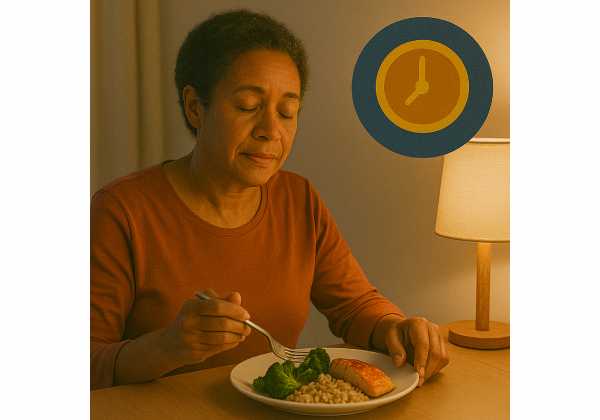
What you eat matters—but when you eat can decide how well you sleep and how you feel the next day. Chrononutrition aligns meals with the body’s internal clocks so digestion, hormones, and brain rhythms work together. Late, heavy dinners can push your temperature and glucose up when your brain wants to cool down and recover; erratic meal timing can drift your body clock and fragment sleep. In midlife and beyond, when sleep grows lighter and metabolic flexibility often declines, timing rules become a simple, powerful lever. This guide turns the science into practical schedules, dinner compositions that actually help, and a two-week plan to personalize your eating window. For a broader foundation on recovery habits that support healthspan, explore our concise hub on sleep, stress, and recovery.
Table of Contents
- How Metabolic Clocks Interact with the Circadian System
- Time Restricted Eating Windows: What Works for Sleep
- Breakfast, Dinner, and Late Night Snacking: Best Practices
- Carbs, Protein, and Fat at Dinner: Effects on Sleep Quality
- Sample Schedules by Chronotype and Lifestyle
- What to Monitor: Glucose, Sleep Latency, and Morning Energy
- When to Avoid Tight Eating Windows in Older Adults
How Metabolic Clocks Interact with the Circadian System
Your circadian system is not a single clock; it is a network. The master pacemaker in the brain (the suprachiasmatic nucleus, or SCN) sets the daily rhythm using light from the eyes. Meanwhile, “peripheral clocks” in the liver, pancreas, gut, adipose tissue, and muscles anticipate feeding and activity. These tissue clocks keep time using molecular feedback loops and respond to signals like meal timing, nutrients, temperature, and activity. When these clocks stay aligned—light by day, food in the active phase, fasting and darkness in the rest phase—metabolism runs efficiently: glucose is handled smoothly, body temperature drops on schedule, and the brain gets consolidated sleep.
Meals are the strongest non-light cue for peripheral clocks. A large late dinner can reset liver and gut clocks without shifting the SCN, producing internal misalignment. You feel this as longer sleep latency, more awakenings, and heavier mornings even if total sleep time looks similar. Glucose levels rise higher and stay elevated longer late in the day; gastric emptying slows; core temperature runs warmer—each of these fights the normal nighttime descent that supports deep sleep. In contrast, an earlier, lighter dinner lets temperature and glucose taper so the brain can slip into stable slow-wave sleep.
Three principles make chrononutrition practical:
- Anchor the day: A consistent wake time, outdoor light within an hour of waking, and the first meal in the morning set a clear “start of biological day.” When the start is firm, the end (appetite and sleepiness) follows more predictably.
- Concentrate calories earlier: Shifting a greater share of daily calories to breakfast and lunch typically supports better glycemic control and less evening hunger, which makes stopping earlier feasible.
- Create a gap before bed: A 3–4 hour buffer between finishing dinner and lights out gives digestion time to wind down and helps core temperature fall.
The goal is not austerity. Even modest moves—20–30% earlier dinner time, a smaller evening portion, or moving dessert to lunch—reduce nighttime metabolic load. Most people notice the change first in how quickly they fall asleep and how steady their energy feels by mid-morning.
Time Restricted Eating Windows: What Works for Sleep
Time-restricted eating (TRE) limits daily intake to a consistent window without changing what you eat. For sleep, when the window sits matters more than its exact length. Early TRE—e.g., 08:00–18:00—aligns eating with the active phase, lowers evening metabolic load, and often shortens sleep latency. Late TRE—e.g., 12:00–22:00—may fit busy schedules but keeps digestion active near bedtime and can run hotter and more wakeful at night.
A practical approach is to pick a 12-hour eating window first, then compress gradually to 10 hours if it feels easy, and only then consider 8 hours. Many adults in midlife settle happily at 10–11 hours on weekdays with a slightly wider window on weekends. The sleep payoff usually comes from shifting the end of the window earlier, not chasing the smallest possible window.
Guidelines that tend to work:
- Place the midpoint earlier. Aim for the center of your window to land no later than early afternoon. A 09:00–19:00 window (midpoint 14:00) behaves better than 12:00–22:00 (midpoint 17:00), even though both are 10 hours.
- Keep the last bite early. Finishing 3–4 hours before bed remains the most sleep-friendly rule. On nights you cannot, reduce portion size and choose foods that empty faster (see dinner composition below).
- Favor regularity. A steady window strengthens peripheral clocks. Large daily swings (e.g., 09:00–19:00 on weekdays, 13:00–23:00 on weekends) weaken the signal and erode benefits.
Expectations matter. Some people sleep better immediately; others need 10–14 days for hunger hormones and evening habits to adapt. If you have a drifting body clock (“night owl”), shifting the window earlier by 30–60 minutes every few days can help advance sleep and wake times. Pair the earlier window with earlier outdoor light and a firm wake time for a stronger push; for a step-by-step clock reset, see our guide to circadian alignment basics.
Two common pitfalls: forcing a very tight window that fuels late-night rebound eating, and skipping breakfast only to push dinner large and late. If sleep worsens during late-window TRE, nudge the final meal earlier, add a modest breakfast, and reassess after a week. The aim is to reduce nighttime metabolic noise, not to win a fasting contest.
Breakfast, Dinner, and Late Night Snacking: Best Practices
Breakfast and dinner bookend your metabolic day. The first sets your tone; the second decides how the night goes.
Breakfast that steadies the day
- When: Within 1–2 hours of waking on most days, after getting outdoor light. Skipping occasionally is fine, but habitual late first meals can drift your eating window and push hunger into late evening.
- What: Include 20–35 g protein (eggs, Greek yogurt, cottage cheese, tofu, or a protein smoothie) plus complex carbohydrates and fiber (oats, whole-grain toast, fruit) and some healthy fat (nuts, seeds). This combination dampens mid-morning swings and reduces the pull for late-night snacks.
Dinner that supports sleep
- When: Finish 3–4 hours before lights out when feasible; 2 hours still helps. For very late workdays, split dinner: a smaller early plate and a light later plate rather than one heavy meal at 21:30.
- What: Favor lean protein (fish, poultry, tofu, legumes) with cooked vegetables and moderate complex carbs (quinoa, rice, potatoes). Keep added fats modest and avoid very spicy or acidic dishes late if you are prone to reflux. Large raw salads or very high-fat meals slow gastric emptying and can prolong sleep latency.
- How much: The later the hour, the smaller the portion. A sensible rule is “satisfied, not stuffed.”
Late-night snacking, if you must
- Use a light, protein-forward option (15–25 g protein) with a small complex carb: Greek yogurt with berries; cottage cheese and fruit; edamame; a slice of whole-grain toast with turkey. Avoid chocolate, peppermint, and tomato sauces late if reflux bothers you.
- Keep fluids tapered in the final 2 hours to cut bathroom awakenings.
Alcohol and caffeine context
- Alcohol can knock you out fast but suppresses REM early and fragments the second half of sleep. If you drink with dinner, finish at least 3 hours before bed and alternate with water.
- Treat caffeine as a morning tool. A practical cutoff is 8–10 hours before bedtime; sensitive sleepers often need 10–12 hours. For details on stimulus timing that protects sleep, see our evening playbook on caffeine, alcohol, and late meals.
The big picture: anchor the day with a balanced breakfast, land dinner with enough runway, and keep late snacks simple and small. The payoff shows up quickly in shorter sleep latency and fewer early-morning dips.
Carbs, Protein, and Fat at Dinner: Effects on Sleep Quality
Macronutrient balance at dinner shapes how you sleep, mainly through gastric emptying, core temperature, and glucose dynamics.
Carbohydrates: Moderate complex carbs at dinner can aid sleep onset for some by increasing brain tryptophan availability, especially when paired with protein earlier in the day. But portion and timing matter: a large, late carb load raises glucose and temperature right when the body aims to cool and stabilize. Taper portion size as bedtime approaches, and prefer cooked, fiber-rich sources (potatoes, rice, whole grains) over large late desserts.
Protein: Adequate evening protein (20–35 g) supports satiety, reduces late snacking, and provides amino acids for overnight repair. Dairy or soy can be helpful if tolerated. Very large protein meals late (e.g., heavy red meat right before bed) can still feel “hot” and slow to digest; portion control remains key.
Fat: Dietary fat slows gastric emptying and can prolong postprandial wakefulness if dinner is late. High-fat, late dinners are consistently linked with lighter sleep and more awakenings in sensitive sleepers. This does not demonize fat—just shift heavier, higher-fat dishes to earlier meals, and keep dinner fats moderate (olive oil drizzle instead of deep-fried entrées).
Fiber and plants: Fiber-rich, minimally processed foods are repeatedly associated with better overall sleep quality, likely via glycemic stability and anti-inflammatory effects. In the evening, cooked vegetables are often gentler than large raw salads.
Practical dinner templates
- Early dinner (≥4 hours before bed): Grilled salmon or tofu, roasted potatoes, and sautéed greens; a piece of fruit for dessert.
- Standard dinner (3 hours): Stir-fry chicken or tempeh with mixed vegetables over rice; modest portion of sauce; sparkling water with citrus.
- Late fallback (≤2 hours): Yogurt bowl with nuts and berries; omelet with spinach and a small slice of whole-grain toast; miso soup with tofu and rice. Keep it light, warm, and easy to digest.
If you are chasing more restorative deep and REM sleep, remember that composition supports—but does not replace—timing and light hygiene. For targets and context on what “good” sleep looks like, see our overview of deep sleep and REM goals.
Sample Schedules by Chronotype and Lifestyle
Use these as starting points, not rigid rules. Each preserves a 3–4 hour dinner-to-bed buffer and concentrates calories earlier in the day. Adjust serving sizes and cuisines to fit your preferences and culture.
1) Morning type, standard workday (sleep 22:30–06:30)
- 06:45 Outdoor light; water or black coffee.
- 07:30 Breakfast: oats with Greek yogurt, berries, nuts (30 g protein).
- 12:15 Lunch: grain bowl with legumes or poultry, mixed vegetables, olive oil.
- 16:00 Optional snack if hungry: apple and cheese or edamame.
- 18:30 Dinner: fish or tofu, cooked vegetables, small portion rice or potatoes.
- 21:30 Herbal tea if desired; no calories.
Works well with an 08:00–18:00 eating window.
2) Intermediate type, long commute (sleep 23:00–07:00)
- 07:30 Light breakfast on-the-go: cottage cheese and fruit or egg wrap.
- 12:30 Main meal: large salad with protein and grains, or leftovers from dinner.
- 17:45 Small early dinner at home: lean protein and cooked veg.
- 19:30 Optional small snack if still hungry: yogurt or miso soup.
Window: 08:00–19:30 on weekdays; keep weekends within ±1 hour.
3) Evening type, creative schedule (sleep 00:00–08:00)
- 08:30–09:00 Light + movement walk.
- 09:30 Breakfast: smoothie (milk or soy, fruit, oats, nut butter; 30–35 g protein).
- 14:00 Hearty lunch: legumes or fish, whole grains, vegetables.
- 20:30–21:00 Light dinner: omelet or tofu bowl, cooked veg, small starch.
- 22:30 Wind-down; screens low arousal.
Window: 09:30–21:00 (11.5 hours), which protects a 3-hour runway to sleep.
4) Shift worker (rotating nights)
- Pre-shift (evening): Main meal 60–90 minutes before start; protein-forward with vegetables and modest carbs.
- Mid-shift (02:00–04:00): Very light snack only if needed—yogurt, nuts, or broth.
- Post-shift (morning): Small protein + complex carb (e.g., toast with egg) before daytime sleep to avoid waking hungry.
- Caffeine: Front-load early in the shift; stop 6–8 hours before planned sleep.
- Alcohol: Skip as a sleep aid; it fragments daytime sleep.
For light and melatonin timing on the road or on nights, see our practical guide to morning light and evening darkness to strengthen circadian cues.
5) Active retiree (sleep 22:00–06:00)
- 06:30 Walk outside; water or tea.
- 07:30 Breakfast: eggs, whole-grain toast, sautéed greens.
- 12:00 Lunch: soup and sandwich or legume/grain bowl.
- 17:30 Early dinner: grilled fish or beans, vegetables, small starch.
- 20:30 Herbal tea; relaxation routine.
These templates keep food in the active phase, protect a dinner-to-bed gap, and leave room for culture and preference. Start close to your reality, then nudge times earlier by 20–30 minutes if sleep remains fragmented.
What to Monitor: Glucose, Sleep Latency, and Morning Energy
You do not need a laboratory to know if chrononutrition is working. Track three outcomes for two weeks as you adjust your schedule.
1) Sleep latency and awakenings
- Estimate minutes from “lights out” to sleep. A sustainable target is 10–25 minutes.
- Note the number of full awakenings and how long you stay awake. Late heavy dinners typically lengthen both.
2) Morning energy and timing
- Use a 1–5 scale for alertness in the first two hours after waking. Better-aligned schedules produce steadier mornings and fewer afternoon dips.
3) Glucose patterns (optional)
- If you use a CGM or glucose-capable wearable, watch the post-dinner curve and overnight stability. You want a modest rise after dinner and a gentle overnight slope, not sharp spikes and drops. Even without a device, a subjective “morning heaviness” often tracks with high late-night glucose.
Run a mini-experiment
- Week 1 (observe): Keep current habits. Log meal times, portions (light/standard/heavy), and bed/wake times.
- Week 2 (intervene): Finish dinner 3–4 hours before bed; move your eating window earlier by 60 minutes; concentrate larger calories at breakfast/lunch; keep a light, protein-forward fallback snack only if truly hungry. Maintain a fixed wake time and morning light.
Judge outcomes by patterns, not single nights. Look for a directional improvement: latency trending toward 10–25 minutes, fewer awakenings, better morning energy. If only one metric shifts, keep the plan for another week and reassess.
Troubleshooting
- Still wired at night: Dinner may be too close or too heavy; shift 30–60 minutes earlier and reduce fats/spice.
- Early awakenings: Add a small complex carb at dinner and ensure fluids taper 2 hours before bed.
- Hunger at bedtime: Increase protein at lunch and mid-afternoon; keep dinner moderate but satisfying.
- Unchanged sleep: Re-check caffeine and alcohol timing; both can masquerade as “food timing” problems. For device-specific tips on what to trust (and what to ignore), see our guide to using wearables wisely.
Measure lightly, adjust weekly, and aim for predictable rather than perfect.
When to Avoid Tight Eating Windows in Older Adults
Time-restricted eating can be helpful, but it is not for everyone. Older adults—especially those with multiple conditions—benefit from a cautious, individualized approach.
Be cautious or avoid tight windows if:
- Unintentional weight loss or low BMI: Energy gaps can worsen frailty and muscle loss. Prioritize regular protein (≥1.0–1.2 g/kg/day unless otherwise directed) spaced across three meals. Consider a 12-hour window instead of tighter plans.
- Poor appetite or early satiety: Long fasts may compress intake too much. Use smaller, more frequent meals during the active phase and focus on nutrient density.
- Diabetes with hypoglycemia risk: Medications (e.g., insulin, sulfonylureas) require careful coordination to avoid lows during fasting periods. Adjust only with clinician guidance.
- Gastroesophageal reflux disease: Large, late meals aggravate symptoms and disrupt sleep. Emphasize earlier dinners, smaller portions, and head-of-bed elevation. Tight windows that force big, late meals are counterproductive.
- Chronic pain or sleep disorders: Very late or very small dinners can increase nighttime wakefulness due to hunger or medication timing conflicts. Keep the dinner-to-bed gap, but ensure adequate dinner.
- History of disordered eating: Any fasting framework can trigger unhelpful patterns. Work with a clinician; prefer regular, balanced meals.
Safer defaults for many older adults
- Window: 12 hours (e.g., 07:30–19:30), with a consistent midpoint in early afternoon.
- Dinner: Finish ≥3 hours before bed, modest size, cooked vegetables, and lean protein.
- Protein distribution: Include 20–35 g protein at breakfast and lunch to protect muscle and reduce late-night hunger.
- Hydration: Front-load fluids and taper in the last 2 hours to reduce bathroom trips.
Quality over strictness wins here. The biggest sleep improvements come from moving the last meal earlier, not from chasing an 8-hour window. Start with regular timing, gentle earlier dinners, and steady protein. Add or remove structure slowly, guided by sleep, energy, and weight stability.
References
- The effects of time-restricted eating on sleep in adults (2024) (Systematic Review)
- Early time-restricted eating advances sleep in late sleepers (2023)
- Metabolic Effects of Late Dinner in Healthy Volunteers—A Randomized Crossover Clinical Trial (2020) (RCT)
- Association between meal timing and sleep quality (2024)
- The interrelationship between sleep, diet, and glucose metabolism (2023) (Review)
Disclaimer
This article is educational and is not a substitute for professional medical advice, diagnosis, or treatment. Meal timing changes can affect glucose control, weight, and medication needs. Consult a qualified clinician before starting time-restricted eating if you have diabetes, gastrointestinal disease, unintended weight loss, a history of disordered eating, or multiple chronic conditions. If sleep problems persist for more than a few weeks or impair daytime function, seek clinical evaluation.
If this guide was useful, please consider sharing it on Facebook, X (formerly Twitter), or any platform you prefer, and follow us for future updates. Your support helps us continue creating clear, practical resources on sleep and healthy aging.










